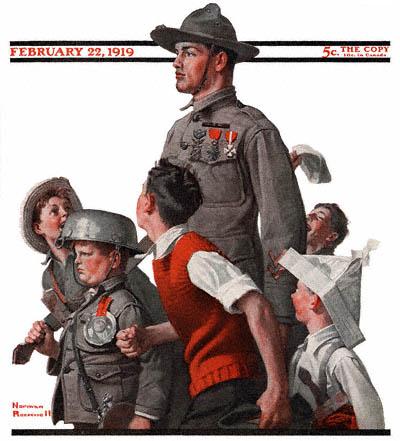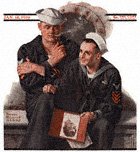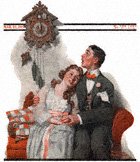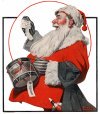 |
|||||||||||||||||||
World War I Soldier Marching with Children by Norman Rockwell
February 22, 1919 Issue of The Saturday Evening PostWorld War I Soldier Marching with Children, this Norman Rockwell painting, appeared on the cover of The Saturday Evening Post published February 22, 1919. An alternate title for this painting is The Doughboy and His Admirers. This painting was Rockwell's sixteenth overall picture out of 322 total featured on the cover of The Post. Rockwell's career with the Post spanned 47 years, from his first cover illustration, Boy With Baby Carriage in 1916 to his last, Portrait of John F. Kennedy, in 1963. Thois was also the second Rockwell cover in 1919. The Post featured a Rockwell illustration on its cover eleven times in 1919. The original oil on canvas painting, 24.5 x 21.5 inches or 62 x 54.5 cm, is part of a private collection. This painting has reproduced in two Rockwell commentary books, as illustration 112 of Norman Rockwell: Artist and Illustrator by Thomas Buechner and on page 78 of Norman Rockwell, A Definitive Catalogue by Laurie Norton Moffatt. On December 3, 2009, the original painting was sold at auction at Sotheby's New York. The high bidder paid $662,500 for the original oil on canvas, which exceeded the upper lomits of its pre-sale estimate of $125,000 to $175,000. The painting was previously the property of Fleet Bank of Providence, Rhode Island. Fleet Bank was apparently taken over by Bank of America, which liquidated the painting. Original copies of this magazine cover in pristine condition have been bought for well over one hundred dollars on eBay. And it only cost a nickel when it was new. World War I Soldier Marching with ChildrenGiclee Prints on Archival Paper: At the time of publication, World War I hostilities had ceased for three months. The German Kaiser had abdicated in November 1918 and peace certainly looked to be at hand. It was only natural that Rockwell depicted soldiers returning home to their families, friend and hometowns. Rockwell usually painted current events. Here we see a World War I soldier returning to his hometown. He wears three medals on his chest. He is a returning war hero. Can anyone identify the medals he wears? Rockwell was a stickler for authentic details, so the medals are likely real World War One medals. He walks like he is still marching in formation. In fact, he is marching in formation. His fellow soldiers are all children. His fellow soldiers are a rag-tag bunch. Only one wears a helmet, and that is actually a soup-pot. That same child wears a very large medal and carries a sword. He also wears a very serious look on his face. World War I Soldier Marching with Children was only one of 322 Norman Rockwell Saturday Evening Post covers; Here is the list of Norman Rockwell Saturday Evening Post cover illustrations.
Here is the complete list of all Norman Rockwell magazine covers. One other child wears a sword in his scabbard. That child also wears a hat made of newspaper. The rest of the children are all weaponless and dressed in civilian clothes. Most importantly, they are all glad to welcome their war hero home.
(Image Only) Copyright © 1919 Saturday Evening Post & Curtis Publishing Company
Remember to check back often.
|
Norman Rockwell Quotes:I'll never have enough time to paint all the pictures I'd like to. No man with a conscience can just bat out illustrations. He's got to put all his talent and feeling into them! Some people have been kind enough to call me a fine artist. I've always called myself an illustrator. I'm not sure what the difference is. All I know is that whatever type of work I do, I try to give it my very best. Art has been my life. Right from the beginning, I always strived to capture everything I saw as completely as possible. The secret to so many artists living so long is that every painting is a new adventure. So, you see, they're always looking ahead to something new and exciting. The secret is not to look back. I can take a lot of pats on the back. I love it when I get admiring letters from people. And, of course, I'd love it if the critics would notice me, too. You must first spend some time getting your model to relax. Then you'll get a natural expression. More at BrainyQuote. Rockwell Favorites
|
||||||||||||||||||
|
|
|||||||||||||||||||
|
Images are copyrighted by their respective copyright holders. Graphic Files Protected by Digimarc. Contact us for details about using our articles on your website. The only requirements are an acknowledgement and a link.
|
|||||||||||||||||||


















